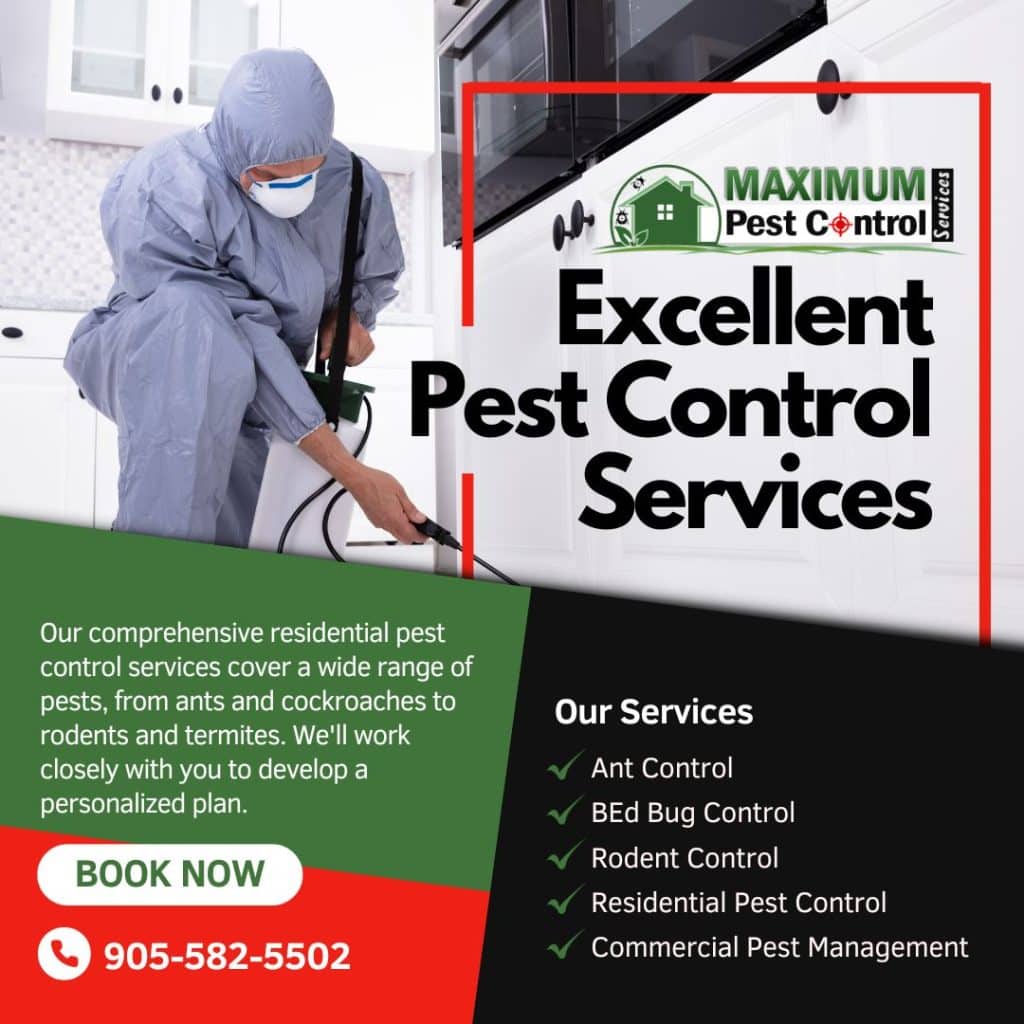Restaurant Pest Control Service by Maximum Pest Control Services
Require Restaurant Pest Control Services? Connect With Maximum Team Today (905) 582-5502
Our insured and bonded team of certified exterminators will conduct a thorough inspection for your place, identify hidden potential problem areas, and implement effective pest management strategies. We use environmentally friendly ministry approved pest control products that are safe for your staff and customers. Our main goal is to ensure your restaurant remains a pest-free zone, allowing you to focus on providing excellent service and clean delicious food.
Keeping Your Restaurant Pest Free
As a restaurant owner, you know how important food safety and cleanliness are. Even a small pest problem can quickly escalate into a reputation-damaging situation if customers spot evidence of insects or rodents. Implementing a thorough pest control plan is essential for any food service business. This post covers key strategies for keeping your restaurant pest-free.
Inspect the Premises
Conduct regular walk-through inside and outside your building to check for signs of pests. Look for things like droppings, gnaw marks, rub marks, and actual insect sightings. Pay particular attention to areas like storage rooms, boxed goods, and anywhere moisture collects. Check under sinks, equipment, floor mats and drains. Don’t forget to inspect the full perimeter of the building, as pests can enter through small cracks. Schedule inspections monthly, or more frequently if you’ve had a problem before.
Manage Waste Properly
Pests feast on scraps, so limiting their access to garbage is crucial. Use tight-fitting lids on both indoor and outdoor bins. Never overfill containers. Pick up debris around dumpsters. Schedule waste removal at least twice per week to avoid accumulation. Recycling should also be promptly removed in covered bins. Keep trash storage areas clean by power washing regularly. Staff should understand that improperly handled waste can attract pests.
Install Physical Barriers
Mice can squeeze through holes the size of a dime, while rats only need a quarter-sized opening. Cockroaches can slide under a door. Physically blocking access points helps stop pests before they get in. Seal any pipe penetrations, cracks and crevices around the building’s exterior using weather-resistant sealant. Hardware cloth, copper mesh or steel wool around potential entry points also helps. Limit pest accessibility under doors by installing door sweeps. Screen vents and openings like air conditioning units.
Manage Landscaping
Pests don’t like open, exposed areas. Keep vegetation, bushes and debris at least three feet away from the building’s exterior walls. Prune back tree branches and shrubs that touch or overhang the roof. Maintain a one-foot gravel perimeter around the foundation if possible. Stack firewood away from the building. Avoid excess mulch buildup right against walls. Adequate exterior lighting also helps discourage pests.
Store Food Properly
Rats and mice are attracted to food odours and can chew through packaging. All food items must be sealed tightly in pest-resistant containers like glass, metal or rigid plastic. Cardboard and bags won’t keep pests out. Ensure lids and containers have no gaps or openings. Avoid storing food on the floor or against walls. Utilizing first in, first out approach when rotating ready to go items. Organize storage areas for easier cleaning and inspection. Keep dry goods area clean and dry.
Manage Plumbing
Flies and roaches need moisture to survive, while rats and mice are attracted to water sources. Promptly repair any leaky plumbing fixtures or pipes. Ensure floor drains always have water in the traps. Routinely clean out grease traps according to code. Keep dishwasher and sink areas dry. Don’t let water pool under equipment or wet mops sit around. Routinely sanitize dump sinks, rinse sinks and janitorial sinks. Pipe chases should be sealed.
Train Staff Properly
Employees play a critical pest prevention role. They should understand basic integrated pest management principles and habits of common pests. Ensure they know proper receiving procedures like inspecting deliveries for bugs. Make sure protocols for storage, cleaning and waste handling are followed. Encourage staff to immediately report any sightings or pest evidence. Recognize employees who proactively identify pest issues.
Conduct Preventative Maintenance
Cracks and equipment issues can allow pests to enter and flourish. Repair cracks in walls or floors right away. Make sure window screens and seals are intact. Identify leaky faucets, pipes and condensation issues. Ensure doors close tightly and don’t gap. Repair any openings around wiring. Keep ventilation systems clean. Monitor for moist environments. Having a facilities maintenance plan helps avoid problems.
Work with Professional Pest Control Company
Even with rigorous prevention, pests happen. Partner with a licensed pest management professional as an ongoing resource. They can provide services like:
- Thorough facility inspections to identify vulnerabilities
- Proactive maintenance recommendations
- Expert identification of any pests found
- Targeted, effective treatment plans
- Detailed record-keeping
- Adherence to all regulations
- Staff training opportunities
- Follow-up evaluations of interventions
A pest control technician can check traps and monitor key areas. They can also provide guidance as seasons and conditions change throughout the year. Work together to quickly resolve any issues that emerge.
Implement Integrated Pest Management
Modern pest control combines multiple proactive tactics rather than just relying on chemicals alone. It’s customized for your site and situation. Measures include facility maintenance, sanitation, staff training, trapping, non-toxic treatments, and limited chemical use only when necessary. You want to take away reasons pests would be attracted in the first place. An integrated pest management plan attacks the problem from multiple angles.
Prioritize Kitchens and Dining Areas
As major food sources, kitchens and dining rooms warrant extra attention. Be meticulous about following sanitation procedures in these spaces. Conduct self-inspections frequently, especially under appliances and equipment. Look for droppings, grease accumulation, water leaks and holes. Kitchen staff should receive training on pest prevention practices. Any issues observed should be immediately addressed. Keeping kitchen and dining areas pest-free is critical.
Maintain Diligent Prevention Daily with Our Restaurant Pest Control Checklist
Pest management shouldn’t only happen when you see a problem. Follow these tips every day to avoid issues in the first place:
- Take trash out frequently
- Quickly clean up spills
- Keep all surfaces spotless
- Check under appliances often
- Inspect deliveries thoroughly
- Seal food tightly
- Limit clutter and cardboard
- Fix drips immediately
- Scan for openings inside and out
- Communicate pest concerns
By making pest management part of your daily routines, you can help avoid both health risks and reputation problems from infestations. Staying vigilant is essential.
Implementing proactive, integrated pest management requires commitment from owners, managers and staff. But the substantial benefits make the effort well worthwhile. Stopping pests before they become established saves major headaches down the road. A pest-free restaurant provides a safer, more appealing place for customers to dine. Protect your business, diners and brand by keeping your restaurant pest-free.
Ensuring the safety and cleanliness of your establishment, our restaurant pest control service provides comprehensive solutions for your specific needs, aiming to restore peace and comfort in your dining space. Contact Maximum pest Control Services Today (905) 582-5502 or (289) 396-5426.





